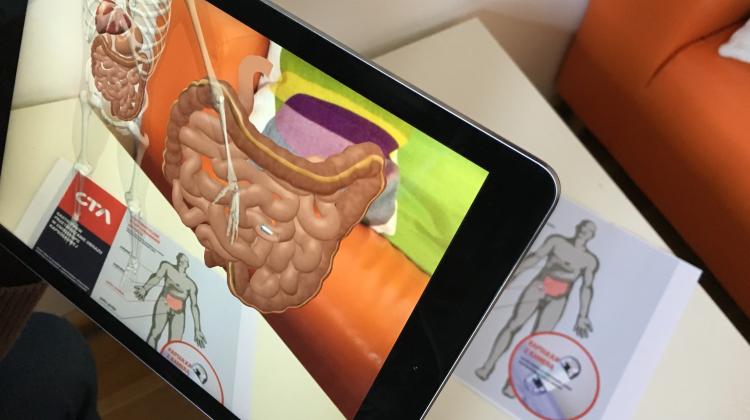Spot each ulcer inside the gastrointestinal tract
 Test simulation in Augmented Reality - the capsule travelling inside the intestine. Source: CTAdventure
Test simulation in Augmented Reality - the capsule travelling inside the intestine. Source: CTAdventure
Oral application capsules with a cam that allow to perform wireless endoscopic examination of the interior of the gastrointestinal tract are available on the market. Polish company is preparing software that will help doctors in a fast and accurate analysis of recordings that may last up to 8 hours.
Endoscopic examination is useful in the diagnosis of problems with the digestive system - detecting tumours, bleeding, ulcers, parasites. A camera has to be introduced into the digestive system. In traditional endoscopes, a cam is placed on a long wire, making the examination uncomfortable for the patient.
Less invasive solution have already appeared on the market: capsules with cameras, which the patient swallows, and they pass through the gastrointestinal tract and record any irregularities in the digestive system. Video recording is transmitted wirelessly to the receiver in a vest or belt that the patient wears. This solution applies in particular to the small intestine and colon examination.
The examination is comfortable, but the analysis of material - a little less so. Video recording time of the capsule is up to 8 hours. The doctor has to review this long video carefully to find irregularities in the digestive system. Polish company CTAdventure, with funds from the National Centre for Research and Development, is working on the software GastroView for image analysis. It will detect these part of video recording, to which the doctor should pay special attention.
"Our software is designed to enable efficient and reliable analysis of videos made with capsule cams - Dawid Jereczek of CTAdventure said in an interview with PAP. - This will shorten the time needed for analysis of the recording and reduce the number of hours that a physician must spend reviewing it". According to Jereczek, the program would select the parts that require special attention. Now an examination with endoscopy capsule can cost up to 4-5 thousand zlotys. Jereczek believes, however, that with the software the cost of could drop by at least half. "It is possible that one day this type of examination will be refunded. And then more people will be able to afford prophylaxis" - Jereczek hopes.
"According to our estimates, detection rate of lesions will grow by 20-25 percent" - said Jereczek. How noted that the fact that sometimes not all changes are detected that could be detected, may be due to the fact that the doctor loses focus during the analysis of a long recording. Meanwhile, GastroView could alert the doctor of important parts of the recording or select those fragments which the physician should specifically review.
The software will also allow to count lesions, map gastrointestinal tract and archive images of endangered parts of the digestive system.
Jereczek emphasised that with funds from the National Centre for Research and Development it will be possible to perform examinations of both patients with diseases of the gastrointestinal tract, as well as healthy individuals. "We will create a database of recordings analysed by doctors. Because experts must show us frame by frame how to recognize changes and what to look for" - explained Jereczek.
The software is expected to be available in 2019. - Initially will be available in Poland, and over time also on foreign markets. Physicians or centres performing endoscopic examination will be allowed to purchase a license to perform specific tests.
PAP - Science and Scholarship in Poland, Ludwika Tomala
lt/ mrt/
tr. RL
Przed dodaniem komentarza prosimy o zapoznanie z Regulaminem forum serwisu Nauka w Polsce.















